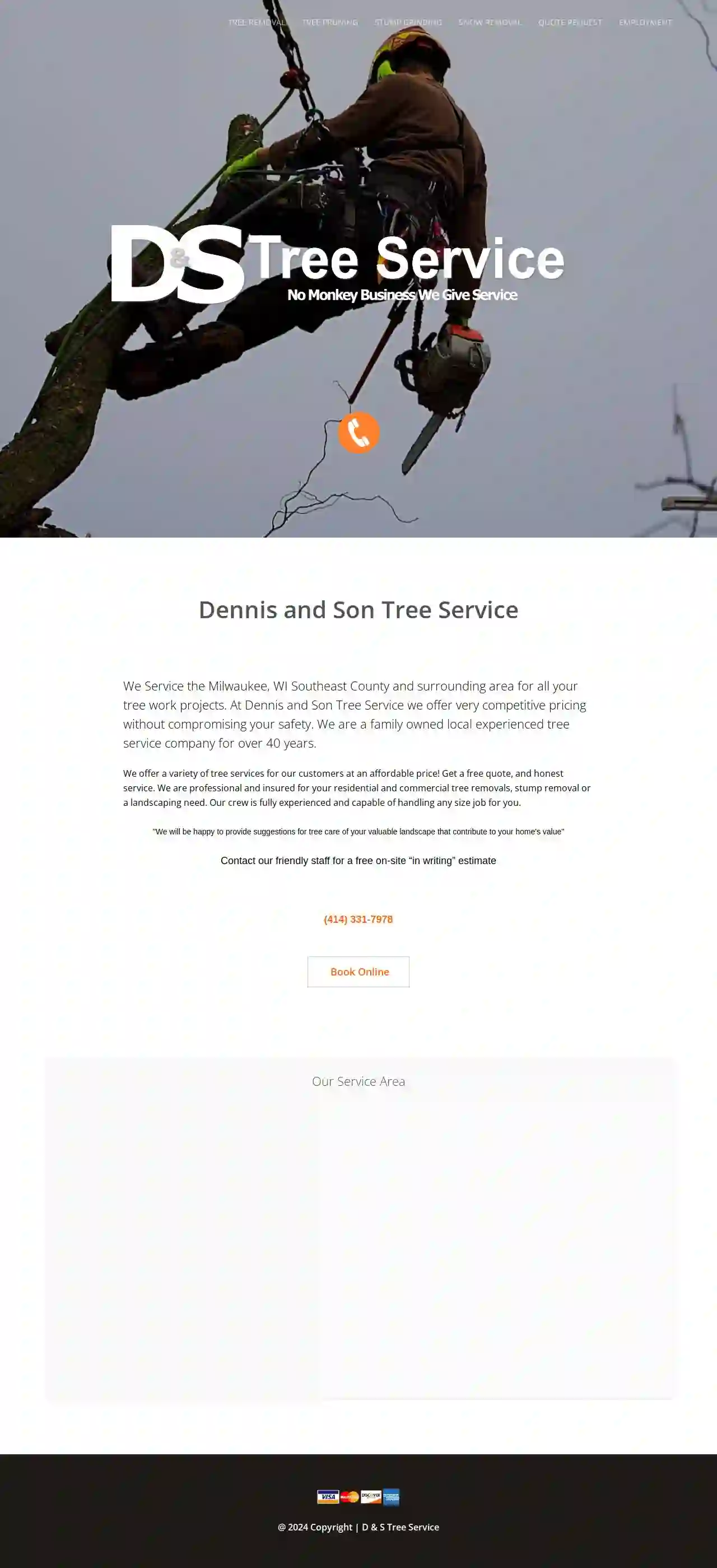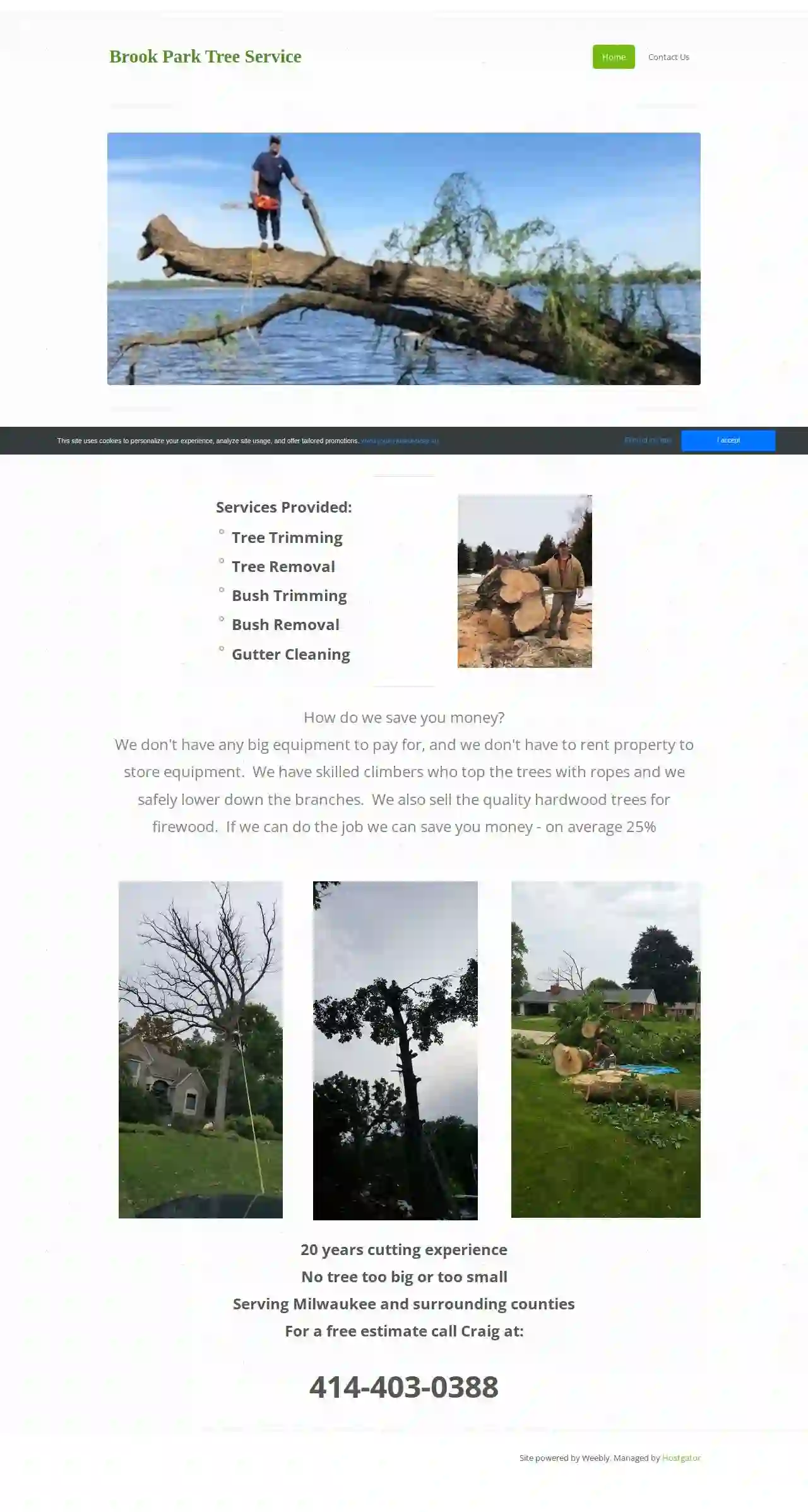Tree Trimming Milwaukee
Best Tree Trimming in Milwaukee
Get up to 3 Tree Trimming quotes for your project today! Compare profiles, reviews, accreditations, portfolio, etc... and choose the best deal.

Danny's Tree Services LLC
523 reviewsMilwaukee, US- Services
- Why Us?
Get Quote
Forester Tree Service
4.420 reviews8525 N 87th St, Milwaukee, 53224, USForester Tree & Plant Health Care Service, Inc. doing business as Forester Tree Service is a professional tree service and maintenance company that specializes in preventative plant health care from the ground up–roots to shoots. They provide value-added services at competitive rates, use environmentally-friendly techniques and materials, and adhere to accredited tree care industry standards. Their team of ISA exam certified arborists are dedicated to providing high-quality expert tree care.
- Services
- Why Us?
- Accreditations
- Our Team
- Testimonials
- Gallery
Get Quote
Dennis & Son Tree Service
4.84 reviews1234 Elm Street, Milwaukee, WI, 53220, USDennis and Son Tree Service is a family-owned local experienced tree service company for over 40 years, offering competitive pricing without compromising safety. They provide a variety of tree services for residential and commercial needs, including tree removal, pruning, stump grinding, and snow removal. Their crew is fully experienced and capable of handling any size job.
- Services
- Why Us?
- Accreditations
- Our Team
- Testimonials
- Gallery
Get Quote- Gr
Gridiron Grinders Tree Stump Removal LLC
4.812 reviewsGridiron Grinders HQ, Beverly Hills, CA, 123 Fantasy Lane, 90210, USGridiron Grinders is a sports analytics and fantasy football platform that provides insights, rankings, and advice to help users make informed decisions in their fantasy leagues. Founded by a team of passionate football fans and data enthusiasts, Gridiron Grinders aims to bridge the gap between traditional fantasy football advice and advanced analytics. Their mission is to empower users with the tools and knowledge they need to dominate their fantasy leagues.
- Services
- Why Us?
- Accreditations
- Our Team
- Testimonials
- Gallery
Get Quote 
Brook Park Tree Service LLC
539 reviewsMilwaukee, US- Services
- Why Us?
- Gallery
Get Quote
Over 1,985+ Arborists on our platform
Our tree removal contractors operate in Milwaukee and beyond!
TreeServiceMatch has curated and vetted Top Tree Service Companies near Milwaukee. Find a top & trustworthy business today.
Frequently Asked Questions About Tree Trimming
- Species: Some trees require more frequent trimming than others.
- Age: Younger trees benefit from more frequent pruning to establish good structure.
- Health: Diseased trees might need more frequent attention.
- Growth rate: Faster-growing trees require more regular pruning.
- Location: Trees near structures or power lines might need more frequent trimming for safety.
- Make clean cuts: Use sharp, clean pruning tools to prevent the crushing or tearing of branches, reducing the risk of disease and decay.
- Follow the branch collar: This is the swollen area at the base of the branch. Never cut back into the branch collar, as this creates a wound that is difficult for the tree to heal.
- Remove dead, damaged, or diseased branches: This improves tree health and reduces hazards.
- Thin the crown: Selectively remove branches from within the crown to improve light penetration, air circulation, and reduce wind resistance. Thinning helps to maintain the natural shape of the tree without reducing its overall size.
- Reduce the crown: If necessary, reduce the size of the crown by shortening the branches back to strong lateral branches. This helps manage the size of the tree without damaging it.
- Avoid topping: Topping is a harmful practice that creates ugly growth and weakens trees. Never top your trees.
- Size and shape of the tree: The larger the tree, the more extensive the work will be.
- Accessibility: If the tree is difficult to reach, specialized equipment might be needed.
- Type of pruning required: Crown reduction or thinning can increase costs.
- Location: Regional differences in labor costs will affect pricing.
- Waste disposal: Removing and disposing of pruned branches adds to the expense.
- Use sharp, clean tools: Dull tools can cause tearing or crushing of the branches and increase the risk of disease.
- Wear safety gear: Protective clothing, eye protection, and gloves are crucial.
- Inspect the tree: Identify the branches that need pruning, such as dead or damaged branches.
- Use proper pruning techniques: Make clean cuts, following the branch collar. Don't remove too much of the crown in a single session.
- Dispose of the branches responsibly: Chip the debris or dispose of it according to local guidelines.
How often should I trim my trees?
A general guideline is to have trees inspected at least every 1-2 years by a certified arborist. They can create a tailored maintenance plan that includes the appropriate pruning schedule.
What is the best way to prune a tree?
For complex pruning tasks, such as crown reduction or thinning, it's strongly recommended to hire a certified arborist who has the expertise and experience to perform the work properly and safely.
How much does it cost to trim a large tree?
Requesting quotes from multiple tree care companies is highly recommended for receiving competitive pricing and accurate estimates for large tree trimming projects. TreeServiceMatch will help you compare your options and make an informed choice.
How to prune a tree safely?
How often should I trim my trees?
- Species: Some trees require more frequent trimming than others.
- Age: Younger trees benefit from more frequent pruning to establish good structure.
- Health: Diseased trees might need more frequent attention.
- Growth rate: Faster-growing trees require more regular pruning.
- Location: Trees near structures or power lines might need more frequent trimming for safety.
A general guideline is to have trees inspected at least every 1-2 years by a certified arborist. They can create a tailored maintenance plan that includes the appropriate pruning schedule.
What is the best way to prune a tree?
- Make clean cuts: Use sharp, clean pruning tools to prevent the crushing or tearing of branches, reducing the risk of disease and decay.
- Follow the branch collar: This is the swollen area at the base of the branch. Never cut back into the branch collar, as this creates a wound that is difficult for the tree to heal.
- Remove dead, damaged, or diseased branches: This improves tree health and reduces hazards.
- Thin the crown: Selectively remove branches from within the crown to improve light penetration, air circulation, and reduce wind resistance. Thinning helps to maintain the natural shape of the tree without reducing its overall size.
- Reduce the crown: If necessary, reduce the size of the crown by shortening the branches back to strong lateral branches. This helps manage the size of the tree without damaging it.
- Avoid topping: Topping is a harmful practice that creates ugly growth and weakens trees. Never top your trees.
For complex pruning tasks, such as crown reduction or thinning, it's strongly recommended to hire a certified arborist who has the expertise and experience to perform the work properly and safely.
How much does it cost to trim a large tree?
- Size and shape of the tree: The larger the tree, the more extensive the work will be.
- Accessibility: If the tree is difficult to reach, specialized equipment might be needed.
- Type of pruning required: Crown reduction or thinning can increase costs.
- Location: Regional differences in labor costs will affect pricing.
- Waste disposal: Removing and disposing of pruned branches adds to the expense.
Requesting quotes from multiple tree care companies is highly recommended for receiving competitive pricing and accurate estimates for large tree trimming projects. TreeServiceMatch will help you compare your options and make an informed choice.
How to prune a tree safely?
- Use sharp, clean tools: Dull tools can cause tearing or crushing of the branches and increase the risk of disease.
- Wear safety gear: Protective clothing, eye protection, and gloves are crucial.
- Inspect the tree: Identify the branches that need pruning, such as dead or damaged branches.
- Use proper pruning techniques: Make clean cuts, following the branch collar. Don't remove too much of the crown in a single session.
- Dispose of the branches responsibly: Chip the debris or dispose of it according to local guidelines.